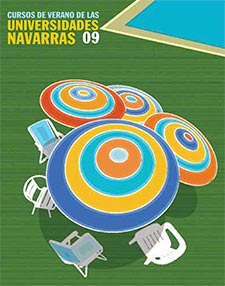BRINGING THE HERITAGE CLOSER. ESTELLA, ART AND THE ROAD
August 26, 2009
A city born for the Camino. visit guided tour of the city of Estella
D. Román Felones Morrás. Full Professor of Geography and History of the I.E.S. Tierra Estella.
One more year, and following an already classic model , the Chair of Heritage and Navarrese Art programmed in Estella a summer course graduate "Acercar el Patrimonio. Estella, Art and Way".
Among the activities planned was a visit to the city that could complement the theoretical information provided by the professors in charge of giving the lectures, all of them magnificently illustrated with images, in many cases unknown and surprising.
A series of circumstances turned a conventional visit into a somewhat special tour. In the first place, the issue of attendees. The issue of registered participants, 120, present in very good measure, required an additional effort from the attendees themselves and the members of the organization, who helped to make everything work in a reasonable way. Secondly, the motley condition of the staff enrolled in the course, which ranged from prominent art specialists to interested citizens with no special training. The speaker made clear from the beginning the informative nature of the walk, which was intended to arouse the interest of the latter, even at the cost of not fulfilling the expectations of the former. And thirdly, the previous data shelled by the speakers, which exempted from detailed descriptions, already previously provided by them.
The visit began, with these premises, in the place of San Martin, in a pleasant afternoon that invited to a relaxed walk.
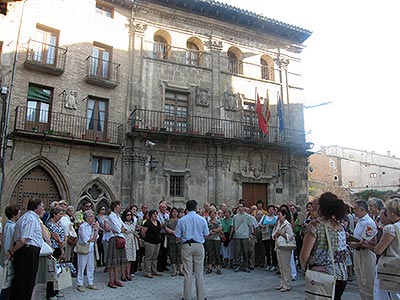
The visit to the city of Estella, to position of Román Felones, began in the place of Martin
The first part was a brief review of the history of Estella, with special emphasis on the birth of the city and the development urban planning of the burghs that make it up. The enumeration and commentary of the four functions that have characterized it historically: commercial, Jacobean, military and religious, closed the explanation in the own place, at the foot of elements as singular as the palace of the Kings of Navarre, the church of San Pedro de la Rúa, the old city council or the source of the four jets. But the medieval character of the city, visible in its religious monuments and its urban planning, is covered by a Renaissance and Baroque shell, which is predominant in the walk through its streets. Calle de la Rúa and Calle Ruiz de Alda, -the beginning of the main street at final - respond well to this typology. A stop at the top of the Cárcel bridge, in spite of the difficulties of its cant, allowed us to observe the framework of the burghs, the walled enclosures, the location of the aljama of Elgacena, some conventual enclosures and the important role played by the river.
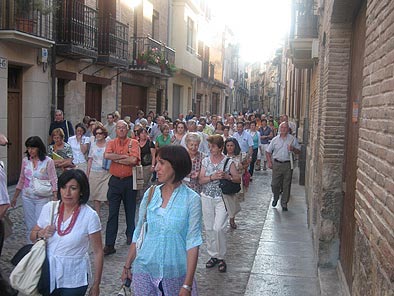
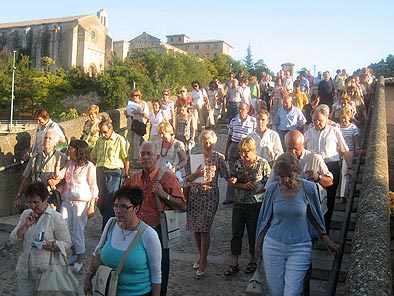
Two moments of the visit to the city, walking along Rúa street and crossing the city by the Cárcel bridge.
The religious building that we were able to observe with special attention was San Miguel, since San Pedro was in the process of restoration. After admiring the façade that Professor Martínez de Aguirre had explained in detail the day before, we went inside, trying to make an architectural and sculptural review of the four styles that have played an important role in the history of art in our Community: Romanesque, Gothic, Renaissance and Baroque.
A final reflection on heritage and the role that corresponds to administrations and citizenship, along with a call of attention on the important challenges that arise in a building as emblematic as San Pedro de la Rúa, closed a visit that was only an invitation to travel. Estella, a city born for the Camino invites to a leisurely tour that the information provided by the speakers throughout the course will undoubtedly help fill in.
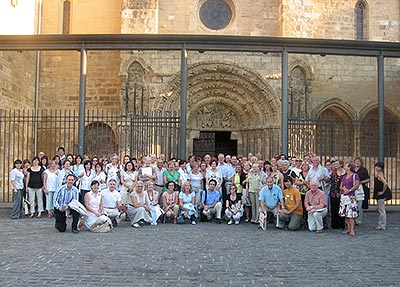
Course participants next to the Romanesque doorway of the church of San Miguel de Estella.
PROGRAM
TUESDAY, AUGUST 25
The splendor of Estella in the Renaissance. Art and Artists
Ms. María Concepción García Gainza. Chair of Navarrese Heritage and Art.
Image of God, image of man: the façade of San Miguel de Estella
Mr. Javier Martínez de Aguirre Aldaz. Complutense University of Madrid
San Pedro de la Rúa: styles and interstyles in a medieval building.
D. Carlos J. Martínez Álava. I.E.S. "Pedro de Ursua" of Pamplona
WEDNESDAY, AUGUST 26TH
Following in the footsteps of the Gothic in Estella: Santo Sepulcro and Santo Domingo
Ms. Santiaga Hidalgo Sánchez. Chair of Navarrese Heritage and Art.
Estella's movable heritage
Ms. Mercedes Jover Hernando. Chair of Navarrese Heritage and Art.
A city born for the Camino. visit guided tour of the city of Estella
D. Román Felones Morrás. Full Professor of Geography and History of the I.E.S. Tierra Estella.
THURSDAY, AUGUST 27TH
Architecture and Humanism in Estella in the 16th century.
Mrs. María Josefa Tarifa Castilla. Chair of Navarrese Heritage and Art.
Traces of the Baroque in Estella
Ms. Pilar Andueza Unanua. Chair of Navarrese Art and Heritage.
The sumptuary arts in Estella: from the Age average to the 19th century.
D. Ignacio Miguéliz Valcarlos. Chair of Navarrese Heritage and Art.
FRIDAY, AUGUST 28TH
Images of a conflict. Estella and the last Carlist War
D. Ignacio Jesús Urricelqui Pacho. Chair of Navarrese Heritage and Art.
reportIdentity and image of Estella in the plastic arts of the 19th and 20th centuries.
Mr. José Javier Azanza López. Chair of Navarrese Heritage and Art.
Museum and city. Gustavo de Maeztu and Estella
D. Gregorio Díaz Ereño. Director of the Jorge Oteiza Museum.
Closing

